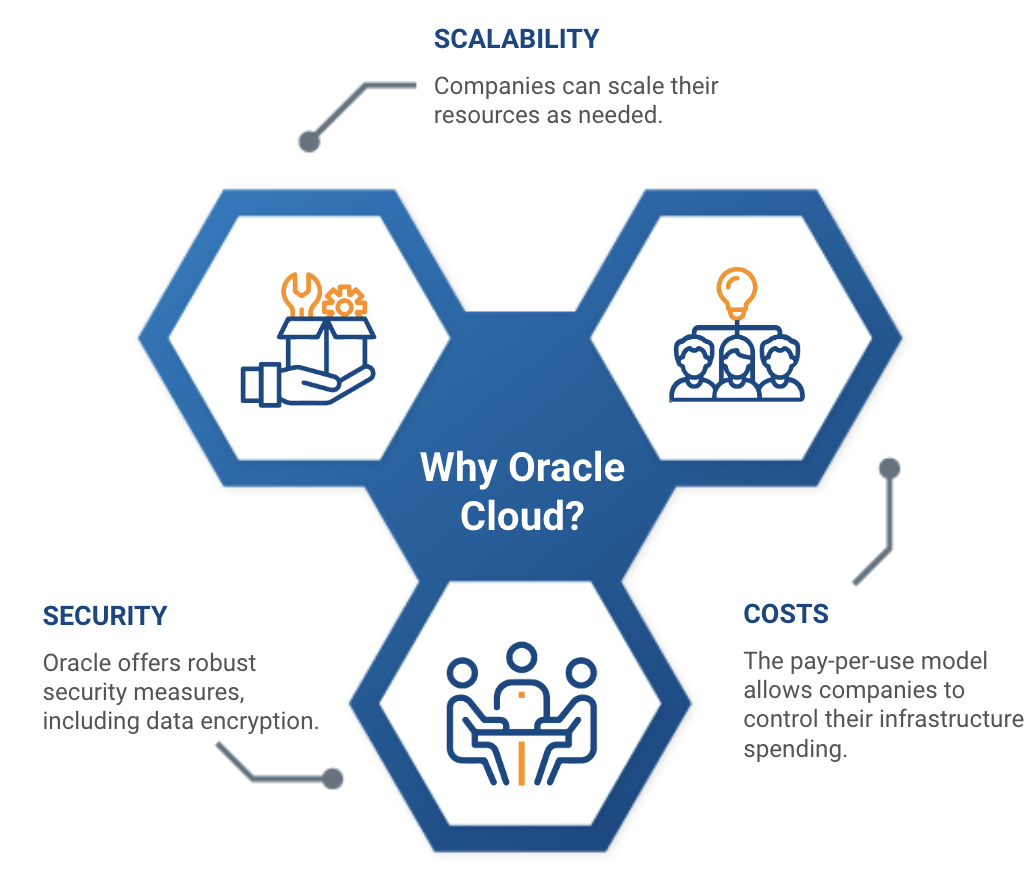
Migrating to the cloud has become a priority for many companies looking to modernize their systems and increase operational efficiency. Oracle Cloud has gained ground as a top choice for this transition, due to its secure infrastructure, scalability, and the ability to integrate advanced technologies such as artificial intelligence and data analytics.
However, successfully migrating to Oracle Cloud requires careful planning, clear strategies, and consideration of a variety of factors. In this article, we will discuss the top strategies and considerations for migrating to Oracle Cloud effectively.
Why choose Oracle Cloud?
Oracle Cloud stands out in the market for its comprehensive approach, covering infrastructure as a service (IaaS), platform as a service (PaaS) and software as a service (SaaS) solutions. Its main advantages include:
- Scalability: Companies can scale their resources according to their needs, which avoids wasting resources or lack of capacity during peak demand.
- Advanced security: Oracle offers robust security measures, including data encryption and compliance with global regulations such as GDPR.
- Cost optimization: The pay-per-use model allows companies to control their infrastructure spending.
Integration with other systems: Oracle Cloud easily integrates with local or hybrid systems, facilitating the adoption of a multicloud environment.
These features make Oracle Cloud an attractive option, but migration is not an automatic process and requires a well-defined strategy.

Strategies for a successful migration to Oracle Cloud
Migrating to Oracle Cloud involves moving applications, databases, and entire systems to a cloud environment. There are different approaches and strategies, depending on the situation and the particular needs of each company. Below are some of the main strategies for effectively migrating to Oracle Cloud.
1. Detailed Assessment and Planning
The first step to a successful migration is to conduct a thorough assessment of your current systems. This includes identifying which applications or data can be migrated immediately and which need modifications or replacements. It is critical to determine compatibility with Oracle Cloud and any potential challenges that may arise.
Some key questions to consider during the assessment include:
- Which systems are critical to the operation of the business?
- What are the performance and security expectations?
- What benefits are expected to be gained from the migration?
- Detailed planning will reduce risks and ensure that the migration is carried out without significant disruption.
2. Decide on the migration model: Lift and Shift or Refactoring
The two main migration strategies are Lift and Shift and Refactoring.
- Lift and Shift: In this strategy, applications are moved directly to Oracle Cloud without making significant modifications. It is a fast and efficient option for companies that want to migrate without investing time and resources in redesigning their applications. However, it may not fully take advantage of native cloud capabilities.
- Refactoring: In this approach, applications are redesigned to better take advantage of Oracle Cloud capabilities, such as auto-scaling or integration with AI. Although it requires more time and effort, it offers greater long-term benefits in terms of performance and efficiency.

3. Phased migration to Oracle Cloud
To avoid significant disruptions to business operations, it is recommended to take a phased migration approach. This involves moving applications or data in a phased manner, allowing for issues to be identified and resolved in smaller stages before moving forward with the full migration. This approach also allows businesses to test the new cloud infrastructure and adjust as needed.
4. Automation and migration tools
Oracle Cloud offers a variety of tools to facilitate the migration process. Using automation tools can reduce human error and speed up deployment time. Some of the most common tools for migrating to Oracle Cloud include:
- Oracle Cloud Infrastructure (OCI) Migration Tools: These tools help migrate applications and databases with minimal disruption.
- Oracle Data Integrator: Allows you to migrate large volumes of data with real-time synchronization.
- Oracle GoldenGate: Ideal for real-time data replication between on-premises systems and Oracle Cloud.
Automation can also help maintain consistency in the migration process and avoid compatibility issues.

Key Considerations During Migration to Oracle Cloud
Migrating to Oracle Cloud is not just about moving applications to the cloud, but also about making sure that all aspects from security to performance are handled properly. Here are some important considerations.
Security and Compliance
During migration, it is essential to ensure that all sensitive data is handled securely. Oracle Cloud offers advanced security measures, but companies must ensure that they implement access, encryption, and auditing policies to protect data integrity. In addition, local and international regulations and rules that may affect the handling of information must be taken into account.
Cost Optimization with Oracle Cloud
One of the most attractive benefits of the cloud is the ability to optimize costs, but this is only achieved with proper management. Companies must implement cost monitoring and control mechanisms to ensure that they are not using more resources than necessary. Oracle Cloud offers monitoring tools that allow you to view resource usage and adjust as needed.
Staff Training
Migrating to Oracle Cloud means IT teams and other departments need to adapt to new tools and processes. Investing in staff training is essential to ensure everyone is prepared to take advantage of the new technologies available in Oracle Cloud and to avoid operational disruptions.
Testing and Validation
Once systems have been migrated, thorough testing is crucial to ensure everything is working as expected. Testing should include:
- Application performance.
- Data security.
- Integration with existing systems.
- Continuous testing during and after migration will help identify issues before they impact business operations.
What makes a successful migration to Oracle Cloud?
Migrating to Oracle Cloud offers a number of benefits, from scalability and security to cost optimization. However, successful migration depends on strategic planning, the use of appropriate tools, and consideration of key factors such as security, staff training, and cost optimization.
Taking a phased approach and leveraging Oracle tools to automate processes can make migration more efficient and less risky.
With the right strategies and considerations, businesses can migrate to Oracle Cloud effectively, positioning themselves to take advantage of the cloud in a competitive and ever-changing business environment.


